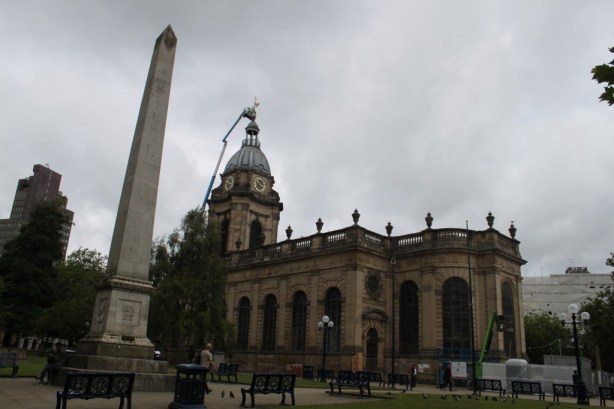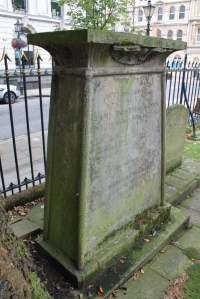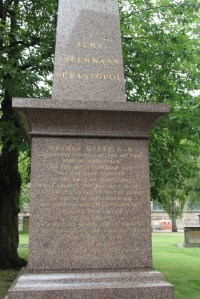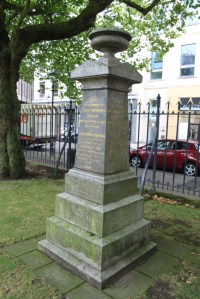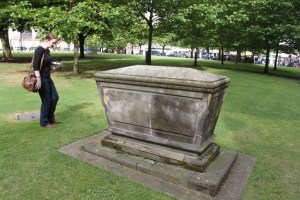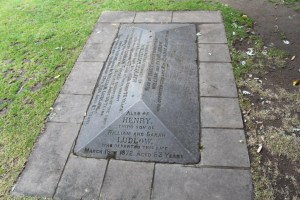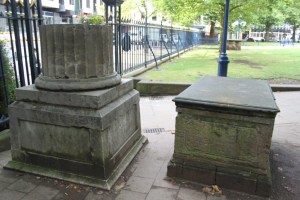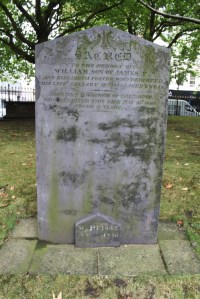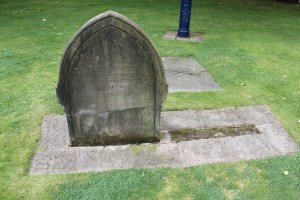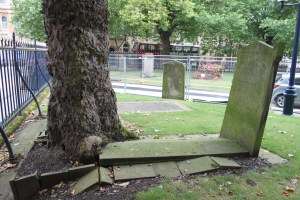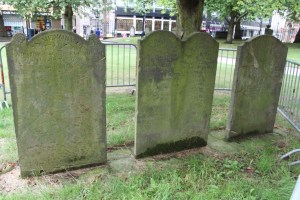From Howard’s Archaeodeath blog. The churchyard of St Philip’s, Birmingham Cathedral, might be regarded as a useful place to ruminate on the futility of remembrance. Over 60,000 bodies are thought to have been interred here between the church’s opening in the early 18th century until its closure for burial in 1859. So few of these received a memorial and only a tiny fraction of these have survived to be viewed today. Commemorate as we might (as Bill and Ted once said, citing the epic masterpiece by Kansas) all we are is dust in the wind... dude.
However, let’s not be so maudlin; let’s instead celebrate the tenacity of select memorials. St Philip’s churchyard was closed to burial in the mid-19th century and subsequently it was laid out as a park in 1910. You would be forgiven for thinking that the memorials were doomed, but through complex processes, some lucky memorials survived and following recent restoration and demarcation by new railings together they collectively rise like a phoenix in Birmingham’s city centre.
Why do some monuments survive? Quite a few reasons I guess. A key linking theme is that they all become valued and conserved by the communities of Birmingham and adopted as municipal monuments (features within managed public space) rather than as private family plots and vaults.
First, some survived because they were the largest and grandest, and hence the most enduring and difficult to justify removal. These are unsurprisingly the memorials of the wealthiest occupants of the churchyard.
Further monuments are a subset of the above, those particularly honoured over the long term because of the particular civic identities and the honoured war dead. Some individuals represent a combination of these qualities, like the memorial to Crimean War Lieutenant Colonel Thomas Unett.
Others are not particularly monumental but their design – through happenstance as much as intention – renders them physically tenacious. Indeed, such low-lying ledgers and low pyramidal monuments are perhaps more enduring than over-blown and elaborate tombs.
Some memorials have been rendered tenacious following conservation, framed with slabs and laid flat.
A further category of memorial to survive are those that form into groups, and those that have been moved into the ‘protection’ of other memorials.

Originally upright, these gravestones have been rendered ‘tenacious’ through conservation and preservation laid flat
There are also ‘tragic’ deaths that ensure survival. An obvious of these are the memorial to a pair of workers – Heap and Badger – who were killed during a building accident in 1833 during construction work on Birmingham’s Town Hall, an accident that had lasting implications in safety at work.
Such working class heroes were afforded a shared memorial: a broken classical column, situated at a prominent location on the south side of the churchyard near one of its principal entrances. Apparently it still affords a focus of trades union assemblies and is further protected by the railings that now prevent it being approached from the front.
Then (and I use the word not to venture my prejudice, but to reflect Victorian attitudes) there are ‘freak’ graves. In Birmingham Cathedral’s churchyard, prominent near the western entrance to the church, is the memorial to the Austrian performer Nanette Stocker, who died in 1819 but only reached a height of 33 inches
A final reason for their survival is their association with a series of cenotaphs that have perpetuated the significance of the churchyard as a commemorative environment. I will discuss these in a future blog.
And of course, these memorials are not static, we encountered examples of fragmented memorials, one recently conserved memorial adjacent to another that is no longer present; the pavement around it serving to commemorate its absence. We also witnessed an example of how root movement and the interaction of memorials and trees creates a tension between different kinds of conservation; the need to conserve trees and memorials together.
In summary, these memorials are in an open public city-centre space and so are constantly open to the elements and assaults from the living; graffiti, vandalism or simply accidents. This is after all a rare open space in a busy urban arena. Hence, when we visited, Ruth and I were fascinated with the careful framing of memorials to protect them, assuring they have the longest lease of life of those luck few who have persisted from the 18th and 19th centuries despite being located in such a busy city centre environment. Indeed, these lucky memorials, given their careful conservation, have a far greater chance of survival through the 21st century than far more recent memorials in typical suburban cemeteries and churchyards.


